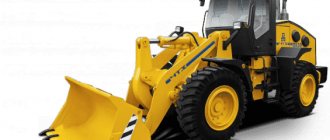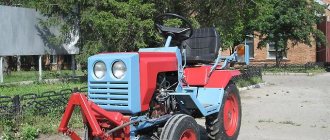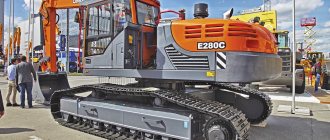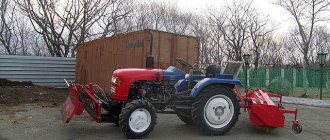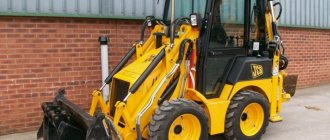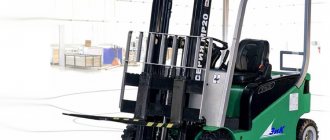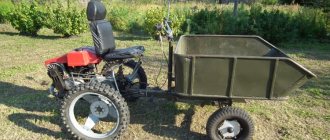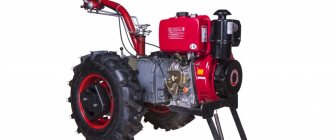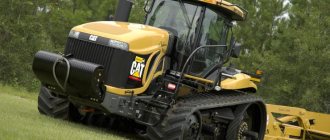During excavation work, situations often arise when it is impossible to use standard equipment, and doing the volume manually is too labor-intensive and time-consuming. You can no longer dig trenches with a shovel and a wheelbarrow.
Where manual labor was previously used, mini-class equipment is now used - smaller copies of full-size equipment (for example, the YuMZ EO 2621 Excavator) that have retained functionality. Multifunctionality, mobility and compactness are valuable in this segment.
The domestic market is represented by models up to 5.5 tons. Mini equipment includes machines weighing up to 10-12 tons, but anything that weighs more than 8 tons can hardly be called “mini” - the characteristics are too close to full-size models, such as the Hyundai H940S loader.
The situation on the market for domestically produced mini-excavators is twofold:
- on the one hand I’m not pleased with the assortment , because this is a young direction that began to actively develop not so long ago,
- on the other hand, there is confidence that Russian designers know the specific operating conditions of equipment better than anyone else and, like no one else, will be able to adapt it to conditions that sometimes border on extreme ones.
Mini excavators: review of models and prices
Small dimensions, increased cross-country ability and maneuverability make the mini excavator a literally universal machine, whose services are needed in all areas of activity - construction, agriculture, utilities, etc. In general, this is a smaller analogue of tracked overall loaders, only in this case the weight of the machine will vary by within 0.5-1.5 t.
Kobelco
New models from the Kobelco brand include the 2.49t SK27SR with canopy, the SK10SR weighing just over a tonne and the 1.65t SK17SR. The SK27SR is equipped with an economical 16.6 kW Yanmar engine, a dig-plane shift function and a new anti-spill blade. The digging depth of the machine is 2.32 m, and the unloading height is 3.2 m. A built-in hydraulic pump is used to ensure accurate supply of working fluid when digging and while driving.
Features of the technology
All models of small excavators, whether on tracks or on wheels, are designed to allow large loaders to be operated in tight spaces. In addition, this technique is convenient to use in combination with full-sized machines. A crawler excavator is perfect for tasks in various fields of activity:
- construction of residential areas;
- creation of road lanes;
- laying a new or dismantling an old water supply system;
- arrangement of a garden plot, creation of landscape design in park areas;
- planting and replanting shrubs and small trees.
This technique is successfully used in production areas, closed workshops, hangars, and industrial units. All of the above functions can be performed by special equipment only by maintaining the technical characteristics of a standard excavator on wheels or tracks, but with reduced dimensions.
Rating of the best mini excavator models
The rating of the best models is determined based on the criteria of boom angle, bucket lifting ability, nominal digging depth, operating efficiency, weight and size.
Bobcat E32
The Bobcat excavator is a representative of the 3.2-T loader class with a traditional tail overhang. The model weighs 3219 kg and its dimensions are 466.2x152x242.9 cm. The design contains a Kubota D1803M power unit, which has a power of 24.2 hp.
Thanks to this indicator, the mini excavator can reach speeds of up to 4.7 km/h. The gain on the bucket is 31,500, and the traction force reaches 34,132 N. When working on the ground, a pressure of 29.2 kPa will occur on it. The maximum unloading height in Bobcat E32 is 3.6 m, and the digging depth is 3.4 m. Price is 2,800,000 rubles.
VIDEO: Bobcat E32 operation overview
Kubota RX-153S
The Japanese Kubota miniature excavator weighs 1.5 tons and has a tracked undercarriage. The design has a three-cylinder engine with a power of 18 hp. With. or 13.2 kW. A fairly spacious bucket can be unloaded at a height of up to 2.9 m, and plunged into the ground to a depth of 1.9 m.
The fuel tank holds up to 20 liters, and the hydraulic tank holds 16.2 liters. The volume of the bucket is 0.1 m3, its width is 35-40 cm. The equipment itself has dimensions of 330x120x220 cm. Price - from 600,000 rubles.
VIDEO: Review of the Kubota RX-153S
Geogid 20G
This model weighs slightly more than the previous one - 2.7 tons. The power of the power unit is 13.5 kW, and the travel speed can reach 5 km/h. In terms of size, this is quite a large special equipment, they are equal to the following indicators - 420x140x240cm.
The blade width here is 130 mm, the digging depth is average, up to 3 m, and the unloading height is 330 cm. The mini excavator loader is equipped with a tracked chassis with a width of 125 cm and a length of 183 cm. The bucket can hold up to 0.08 m3 of bulk cargo. The cost of the model is 880,000 rubles.
VIDEO: Geogid 20G operation overview
Trailed excavator J8
This is a trailed wheeled excavator. It has a boom rotation angle of up to 150°. The package includes an engine from the famous brand Honda Lifan. The power of the power unit is 11 kW, while fuel consumption does not exceed 1.5 l/h.
During operation, the lifting height of the bucket is 1.9 m, and its width is 37.5 cm. Price - 250,000 rubles.
VIDEO: Review of J8 operation
Komatsu PC35MR-3
Komatsu mini special equipment has an integrated control system for simplified control of all mechanical components of the equipment.
Hitachi
The Hitachi line of mini-excavators with an operating weight of up to 3 tons is represented by two models with zero offset - Zaxis ZX10U-2 and ZX17U-2, which are equipped with a sliding chassis and a folding dozer blade, providing a narrowing of the chassis if necessary to work in cramped conditions up to 910 and 980 mm respectively. For more efficient movement on the job site, Hitachi mini excavators have two travel speeds. In addition, they can be used with a variety of work attachments. The ZX10U-2 comes with a 9.5kW 3-cylinder engine and weighs 1110kg. The machine is very compact, the operator's seat can be reclined and the hood can be opened entirely, providing full access to the engine. Features of the ZX17U-2 with an 11 kW engine include an external frame made of a D-shaped profile, which protects the excavator body from damage, a reinforced boom articulation pin with the support frame, bushings for all pin connections and a blade with a lubrication interval increased to 500 hours. The machine's hydraulic system includes three pumps. For ease of maintenance, the rear panel of the engine hood slides up and the side cover opens completely. The fuel level can be monitored by an external indicator on the tank. To protect against damage, hydraulic lines are routed inside the handle.
Competitiveness of Russian-made mini-excavators
The demand for small-sized excavators is quite high. This equipment is capable of performing work in conditions where the use of heavy excavators is impossible or impractical. The prefix “mini” does not at all indicate the limited capabilities of the excavator. They can work with various types of attachments and show pretty good performance. In addition, compact equipment is characterized by economical fuel consumption and can work in confined spaces.
Thanks to these features, mini excavators are widely used in public utilities, construction companies and private owners. It is worth noting that Russian-made mini-excavators appeared on the construction equipment market relatively recently. For a long time, cars created in China and Japan reigned here. However, as practice shows, the developments of domestic companies are no worse. We will introduce you to them now.
JCB
The two micro-class models 8008CTS (875 kg) and 8010CTS (1.04 t) are able to fit through a standard 762 mm wide doorway. The JCB 8014, 8016, 8020, 8025, and new 8026 and 8018 mini excavators offer precise control, easy maintenance and an excellent operator environment. All models are compact, making them easy to transport and suitable for working in tight spaces.
The JCB 8014 CTS Mini Excavator weighs 1,564kg and is a minimalist model with a host of innovative design features and a significantly reduced rear platform reach. It has a fixed chassis and is powered by the same 1.1-litre 14.7kW Perkins engine as other 801 CTS cars.
The machine's cast rotating frame ensures high structural strength. This feature of JCB mini excavators has allowed the designers to move the engine and tanks to the rear, eliminating the need for extra counterweight.
The JCB 8014 CTS mini excavator is a lightweight, stable machine that is compatible with a wide range of attachments and buckets.
The new 8026 CTS mini excavator, with a transport weight of 2.7 tonnes, shares many of the same features as the 8025. It is powered by an 18.4kW Perkins 400 Series Tier 3a engine delivering 96kN of torque at 1800rpm. The excavator's rear platform reach is 470 mm greater than that of the 8025 ZTS. Its digging depth is 2.74 m, reach is 4.7 m, and dumping height is 3.22 m. The undercarriage is equipped with three lower rollers, one upper roller, reinforced track tension roller guides, a hydraulic system for adjusting tension and Bridgestone wide tracks 250 mm with small pitch. The travel speed has increased by 11% compared to model 8025. The valve stroke of the hydraulic distributor has increased by 17%.
Geogid
The production line for the production of these machines is located in Chelyabinsk, and belongs to. Currently, the production of three modifications of the Geogid mini excavator has been launched. Here are their brief technical characteristics.
15G. This model was developed specifically for beginning entrepreneurs and private homeowners. This is evidenced by the affordable price and modest capabilities.
Here is a list of the main technical characteristics.
The model in question is produced on caterpillar tracks; the basic package includes a bucket and a dozer blade.
20G. A more powerful car, which, in addition to the basic one, is available in two more trim levels: standard and premium. The difference between the models lies in the level of comfort.
All options have the following features:
- All-metal cabin with panoramic glazing.
- Crawler mover.
- Fully rotating platform.
It is worth noting that the weight of the mini excavator is about 2.3 tons. A thirty-centimeter bucket holds 0.5 cubic meters of soil. The equipment is equipped with gasoline engines with a capacity of 20 horsepower.
60-DC-P. The most powerful representative in its family. The car is equipped with an engine with a capacity of 60 horsepower. The weight of the equipment increased to 2.4 tons.
“Made with us” and on Yandex.Zen
The Mole mini-excavator from St. Petersburg is the fulfillment of the desire of the company owner to simplify the work of builders at least a little.
Over the two years of its existence, the company has already sold 30 mini-excavators, established the production of individual components for used excavators, created various attachments for clients’ tasks, established strong friendly relations with its customers and, most importantly, filled the need for a quality product at an affordable price.
© vk.com
We decided to talk to Yuri Babin, the owner of the company, to find out how an outwardly unsightly test sample of a mini-excavator turned into an attractive and high-quality domestic product, what is currently in stock and how it is possible to maintain such a low price for the products.
Yuri, hello! I'll start with the most obvious question - why Mole?
The excavator digs in the ground like a mole. Mole translated from Latin means mole.
I saw a photo of the first mini-excavator made and it looks different from what you are making now. Was this a test sample? As I understand it, it has proven itself well, since there is now mass production?
Yes, it was a test sample. We made it three years ago and immediately “sent it” to the construction site to identify the “childhood sores” of the product we wanted to produce.
© vk.com
He worked there for four months, we realized that the weak point was in the engine, but there were no other comments.
Having fixed the problem, we decided to launch the excavator into production, but we did not like its appearance. Then we revised its appearance and, using the Kubota K008 as a basis, created a high-quality product. We took the path of import substitution, so to speak: we repeated the mini-excavator of our foreign colleagues.
© vk.com
Mole (white) and its colleague - Kubota K008
Two years have passed since then. What happened during this time?
We have made the excavator accessible to many users who previously could not afford such equipment. We beat Russian competitors in quality, and foreign competitors in price. During this time, we sold 30 units without a single complaint or complaint. There was one warranty issue that we literally fixed in a day.
Now we additionally manufacture attachments that are provided for mini equipment, we manufacture custom parts and assemblies for imported special equipment, and we also assemble tracked chassis of any type and size according to the individual parameters of users.
What kind of attachments do you make? In general, what can excavators do? Who are they targeting?
Attachments for our mini-excavator include buckets of different types and sizes, uprooters, grips for barrels and tree trunks, and drills of any diameter.
We are the only ones who were able to replicate French buckets, which are 1.5 times more efficient than others when working on clay and loam. And this is the “pain” of our Leningrad region.
© vk.com
Buyers are mainly private owners: small construction companies, owners of farms and plant nurseries. Companies that drill water wells, gas and emergency companies, and forestry companies are also interested in our excavators.
Satisfied clients are the best reward!
© vk.com
By the way, the second Mole mini-excavator we manufactured was purchased by the Leningrad Regional Water Supply Company at the AGRORUS exhibition in August 2018.
© vk.com
There were buyers who deal with landscaping and landscaping. They use our mini-excavator and a rotator with a large-diameter drill to make holes for planting trees.
Thanks to its compact size, the excavator can be lifted, for example, onto the roof of a multi-storey building using a freight elevator and the necessary work can be carried out there. Our “mini” is useful in places where a regular excavator cannot go: for work in the basement, when laying communications, networks, and also for removing construction waste. We have created a universal machine that will be useful in both winter and summer.
Tell us in more detail about the competitive advantages of your mini excavators
The first is the price. Our customers do not have to overpay for the brand or the cost of consumables. No transport taxes or recycling fees, which is 700 thousand rubles. The Mole mini-excavator in its basic configuration costs 860 thousand rubles. This is one and a half times cheaper than imported cars.
© vk.com
The second is quality. All spare parts and components are imported from trusted suppliers. In addition, our excavators are assembled and developed by professionals - we have strong electricians, hydraulics, and welders.
Third is simplicity. All maintenance of a mini-excavator comes down to changing the oil every 100 hours, according to the engine manufacturer’s regulations and daily lubrication during operation.
Fourth is customer focus. We work with our clients, making machines tailored to their needs. One had a limited budget, but he needed two pieces of equipment - both a mini excavator and a mini loader. We met halfway: we modified the wide leveling bucket, the bracket (the fastening between the bucket itself and the excavator boom) and it became possible to place the leveling bucket both towards you and away from you. As a result, we received a mini-excavator and a mini-loader with a loading height of 2.4 m.
Do you make equipment to order or sell from stock?
We assemble equipment without waiting for customers, but during the assembly process customers appear. We don’t even have a test sample now - we made one in March and promised ourselves that we wouldn’t sell it. But in the end, the guys from Rostov came and begged him from us.
Let's talk about the service. You don’t have intermediaries; what happens if a mini-excavator breaks down on the other side of the country?
In case of warranty cases, we are ready to come or fly and fix the problem. For those who cannot wait for us, we are ready to send some unit and pay for the work to replace it at any service center closest to the client. In any case, this is faster than replacing spare parts with imported equipment - there, if the parts are not in stock, you have to wait a very long time.
What if the breakdown happened during the season and at a good facility? The reputational losses for clients will be enormous.
Therefore, we made the most simple excavator so that the client could, if something happened, fix any breakdown with minimal effort.
We also accompany all clients who bought mini-excavators from us and clarify their wishes. Well, we are introducing them in new models. If you compare the first model that was launched into production with those that are now - it’s heaven and earth.
© vk.com
How do you fight the stereotype that it is better to spend money on imported goods than to buy domestic ones?
Initially, it was difficult to communicate with people: stereotypes and conservative views remained from ancient times. But usually, when buyers see with their own eyes how an excavator works, their opinion changes. Buyers from other cities often come to us, the latter from Orel and Moscow. We met and agreed that we were not going to look at production, but to visit our customers. Thus, two people signed contracts without even visiting the production facility.
© vk.com
In two years you have scaled production well. What are the company's plans for the next few years? Probably also Napoleonic?
There are a lot of plans.
A business is considered successful when it “sees itself” in 3-5 years. And we see ourselves in the future as a large company that has a large-scale production of earth-moving equipment, excavators, individual components and spare parts.
Thank you, Yuri! We wish all your plans to come true!
EO-112M
This is a Russian mini-excavator, which is also produced in Chelyabinsk. The production line belongs to . The idea to create this machine appeared in 2000. By 2008, the first prototype was created, which entered mass production in 2014. The EO-112M mini-excavator is a crawler-mounted machine with a full-rotating platform. For the caterpillar propulsion, steel tracks with a width of 400-450 mm are used.
Scope of application of mini excavators
Considering their dimensions and a rather impressive set of attachments, mini-excavators are used to solve the following tasks:
- Formation of trenches and small pits. It is worth clarifying that small-sized equipment cannot cope with complex or frozen soils without preliminary loosening.
- Drilling water wells.
- Land planning.
- Construction waste removal.
- Loading of non-metallic materials.
- Dismantling of small brick and wooden buildings.
Domestic mini-excavators have a number of advantages over foreign analogues:
- They are adapted to harsh climatic conditions.
- Spare parts are produced in Russia, so there are usually no problems with purchase and delivery.
- Low prices.
Considering the awakened interest of Russian consumers in this class of equipment, one can hope that the number of models will increase.
Small Russian-made excavator, special equipment on wheels
During excavation work, situations often arise when it is impossible to use standard equipment, and doing the volume manually is too labor-intensive and time-consuming. You can no longer dig trenches with a shovel and a wheelbarrow.
Where manual labor was previously used, mini-class equipment is now used - smaller copies of full-size equipment (for example, the YuMZ EO 2621 Excavator) that have retained functionality. Multifunctionality, mobility and compactness are valuable in this segment.
The domestic market is represented by models up to 5.5 tons. Mini equipment includes machines weighing up to 10-12 tons, but anything that weighs more than 8 tons can hardly be called “mini” - the characteristics are too close to full-size models, such as the Hyundai H940S loader.
The situation on the market for domestically produced mini-excavators is twofold:
- on the one hand I’m not pleased with the assortment , because this is a young direction that began to actively develop not so long ago,
- on the other hand, there is confidence that Russian designers know the specific operating conditions of equipment better than anyone else and, like no one else, will be able to adapt it to conditions that sometimes border on extreme ones.
Information and analytical publication TECHNOmagazine
The small class of excavators began to take root among Russian users relatively recently. Just a few years ago, Russian consumers looked with distrust at small cars that seemed like toys, but not full partners with their larger brothers on the construction site. It was easier to purchase a machine with greater productivity and weight in order to use it for various jobs - to dig a pit or repair a road. However, the trend began to change with the rapid development of cities.
Urban space is becoming denser, and working within it poses many difficulties. Demands on builders are increasingly increasing, and if previously it was enough to fill the foundation pit upon completion of the work, tidy up the area more or less and restore the roadway, now city services require restoration of green spaces and grass cover. And all this costs money. So isn’t it easier to do all the work with a light machine that won’t damage the lawn or break the asphalt?
The building density in some parts of large cities is so high that a large machine simply cannot be used. There is not enough space to turn around and place a large excavator; access to the work site is difficult due to the density of buildings. And sometimes it is not possible to attract several diggers with shovels and spend 2-3 days (or even more) on excavation work due to the short time allocated for the work. And again, isn’t it easier to bring a small excavator and do all the work quickly and as accurately as possible?
And one more thing - often in the urban “jungle” there are places where it is simply impossible to drive a large machine - underground structures, arches of small bridges and other places where it is impossible to use heavy equipment or dig the deepest, but very narrow hole when repairing cables power transmission Here mini excavators will provide invaluable help.
These are all the advantages of using small excavators. Are there any downsides? Yes, there are disadvantages. Firstly, mini excavators have low productivity and small digging depth (compared to large construction excavators). And, secondly, they cannot carry out a significant amount of excavation work - to dig a pit or a deep trench - it will take a lot of time and, probably, a dozen mini-excavators.
Thus, mini excavators can be used in urban construction and repair with minor volumes of excavation work. They will replace a dozen diggers and reduce the time and costs (and in some cases remove them from the estimate altogether) for cleaning the area after work, and will not cause much harm to lawns and plantings.
What mini excavators are presented in Russia
Among foreign manufacturers, Hitachi
and
Bobcat
.
Equipment under these brands is most widely represented in Russia. Kubota
and
Takeuchi
have slightly lower results .
Komatsu
is quite active in this segment .
Bobcat
Bobcat has the widest line of mini excavators in the segment. In the size group with an operating weight from 2 to 5 tons, Bobcat presents 7 models: Bobcat 325; 328; 331; 334; 337; 430; 435. Bobcat models 331, 430 and 435 have an additional modification. Machines 430 and 435 have zero overhang of the compartment and the left/right side of the cabin beyond the dimensions of the tracks. In addition, modifications 430 and 435 Fast Track have increased movement speed compared to 430 and 435 in the regular configuration.
All models of the manufacturer have a hydrostatic transmission, rubber-coated tracks and a diesel engine. The maximum digging depth of the presented models of Bobcat mini-excavators is from 2.55 to 3.58 m. The Bobcat 331, 430 and 435 models can be equipped with an extended handle, which allows increasing the digging depth of these models to 3.91; 3.36; 3.72 m respectively.
Hitachi
Hitachi also has a wide selection of models in the line of mini excavators weighing from 2 to 5 tons and presents 5 models - ZX25, ZX27U-2, ZX30, ZX35 and ZX40. Models ZX35 and ZX30 additionally have one modification each. The engine power of the listed models is from 18.4 to 36 liters. With. The maximum digging depth of Hitachi mini excavators is from 2.83 to 3.75 m, depending on the model. Models equipped with extended arms have a greater digging depth of up to 5.72 m (5.72 m (for ZX40 model).
All models of Hitachi mini equipment are equipped as standard with a hydraulic distributor for additional hydraulic distribution, a two-speed automatic transmission, and a bulldozer blade.
Takeuchi
Takeuchi is a pioneer in the field of compact construction machines. All Takeuchi mini excavator models are equipped with rubber and rubber-metal tracks that minimize vibration even on the hardest ground. Takeuchi excavator models ranging from 2 to 5 tons include the TB125, TB135 and TB145. In addition, the Takeuchi line is complemented by models with a shortened Zero Swing platform, such as TB23R, TB28FR and TB138FR.
The design of Takeuchi mini excavators allows the installation of attachments for various purposes. Models 125, 135 and 145 have an axial piston hydraulic pump that automatically adjusts to load changes.
Kubota
When developing the new KX-3 series of compact excavators, Kubota focused on developing three main characteristics - improved performance, ease of use and environmental friendliness. The line of new mini excavators weighing from 2 to 5 tons is represented by the KX61-3, KX71-3, KX91-3, KX101-3, KX121-3 and KX161-3 models. In addition, the manufacturer’s line includes machines with a shortened counterweight - models U20-3, U25-3, U35-3, U45-3 and U50-3.
Engine power of models with the KX prefix ranges from 24.8 to 40 hp. With. Kubota machines have increased digging force and are capable of carrying out four operations simultaneously. The design takes into account all the necessary safety elements. The cab and roof provide maximum user safety with Roll Over Protective Structure (ROPS) and Falling Object Protective Structure (FOPS).
Komatsu
The Japanese company Komatsu in Russia presents 2 models of mini excavators - these are PC35MR-2 and PC50MR-2, weighing from 3.58 to 5.25 tons and engine power from 29 to 39.4 liters. With. respectively. Both Komatsu machines have a shortened rear end and can be used for work in very cramped conditions - in courtyards, sewer work, etc. The variety of configuration options for the PC35MR-2 and PC50MR-2 allows the operator to choose the right mini excavator for specific jobs. Short or long arm, cab or canopy, rubber or steel track shoes.
The CLSS hydraulic system provides Komatsu mini excavators with the required power, speed and excellent controllability for all movements, including combined movements. It is designed according to a closed center design, contains two control pumps and has the ability to regulate the performance according to the load. The main feature of such a system is that it allows the operator to perform all movements with maximum efficiency, regardless of the load and engine speed.
A little history
The first mini excavator was designed by Yanmar in 1968. And in 1971, their serial production began. The machine was equipped with metal tracks and a turntable in the image and likeness of larger excavators.
In 1979, its cars were equipped with rubber tracks, and in 1994, for the first time, it released a model with a zero turning radius. This gave the mini-machines additional and unique advantages. We can say that it was from this time that the active use of mini excavators by consumers began.
Author: TECHNOmagazine
Share
Description and scope of application
Mini-excavators are divided into tracked and wheeled , they are characterized by simple and ergonomic operation, their small volume and weight allow them to work in hard-to-reach places and, if necessary, quickly replace buckets. Read the article about the difference between tracked and wheeled loaders here.
Many models do not require specialized transport for transportation, and they are much easier to operate than a large machine. The use of attachments allows (albeit in slightly smaller volumes) to perform the same types of work as with a conventional excavator.
Tracked vehicles move five times slower than wheeled vehicles , but can be used on soft or wet clay, in completely off-road conditions, in a pit. For small jobs on scattered objects, wheeled options are more suitable.
There are no fundamental differences in the class of mini-excavators; they all consist of three parts: chassis, superstructure and working equipment. Differences in size, price and performance. Compact equipment has proven itself to be used in various types of activities:
- city utilities, road and emergency services;
- gas and water supply organizations;
- in communications and energy;
- green farms;
- emergency services;
- in small construction;
- in archaeology.
Designers are constantly looking for fundamentally new solutions, and in addition to self-propelled equipment trailed mini-excavators , which are suitable in price and mobility for private owners with small but regular volumes of work. There are options for attaching excavator equipment to mini loaders.
Specifications and price
Geogid
Four high-performance, maneuverable and stable models of mini-excavators, developed by our own design bureau and produced by the Chelyabinsk engineering holding PRIDE :
- 15G – trailed version, 15 hp engine, without cabin, blade and slewing support, equipped with a rotary handle, bucket 0.02 cubic meters, digs 220 cm deep, unloading height 2.5 m, weight 1 t, price 280 thousand rubles;
For more details, watch the videos below:
- 20G-P – self-propelled, 20 hp gasoline engine, price of the base model is 751 thousand rubles;
- 20D – self-propelled, 27 hp diesel engine, price of the base model is 1.18 million rubles;
- 60D – self-propelled, diesel engine 40 hp, price of the base model is 1.235 million rubles;
The productivity of Geogid mini excavators is high due to the fast cycle time . All self-propelled models are equipped with a rotary handle, hood and blade, weigh 2.2-2.4 tons, bucket volume is 0.05-0.06 cubic meters, dig 3 meters deep and unload upward 3.3 meters.
There are three types of configuration for them: “Budget”, “Standard” and “Premium”. The difference is in the options for additional equipment and the level of control comfort. For an additional fee you can get a cab, a slewing ring and a heater.
Full equipment increases the cost of the basic product by 130-150 thousand rubles.
Landformer performance
A trailed model, developed by a German concern, produced by Zelenograd. This technique can single-handedly replace a work team.
Thanks to special grips, Landformer can also work as a mini-loader , solving multiple tasks when removing construction waste, dismantling old buildings and clearing territory. For comparison, read about the characteristics of the JCB loader.
Hanix
The three models in the D series include the "micro" H09 and the "mini" H17 and H27. The Hanix H09D model is one of the smallest models of excavators in the family. The model is ideal for places where work space is very limited. The combination of a fuel-efficient Kubota engine and variable displacement hydraulic pump provides the machine with the fuel efficiency and power to handle all types of major tasks. The mini excavator is controlled by joysticks, which provide precise control and ease of operation for the operator. For greater stability, the tracks can be hydraulically expanded and the blade can be increased to 950 mm, and the low operating weight of only 980 kg allows the H09D to be easily transported and work with minimal ground pressure. The Hanix H09D mini-excavator is equipped with a safety bar that can be folded during transportation if necessary. The new model of the Hanix H27DR mini excavator is suitable for sites where it is necessary to carry out excavation work in limited space. To avoid damaging the coating, rubber tracks are used. The standard handle provides a digging depth of 2.58 m, and the extended one – 2.86 m.
